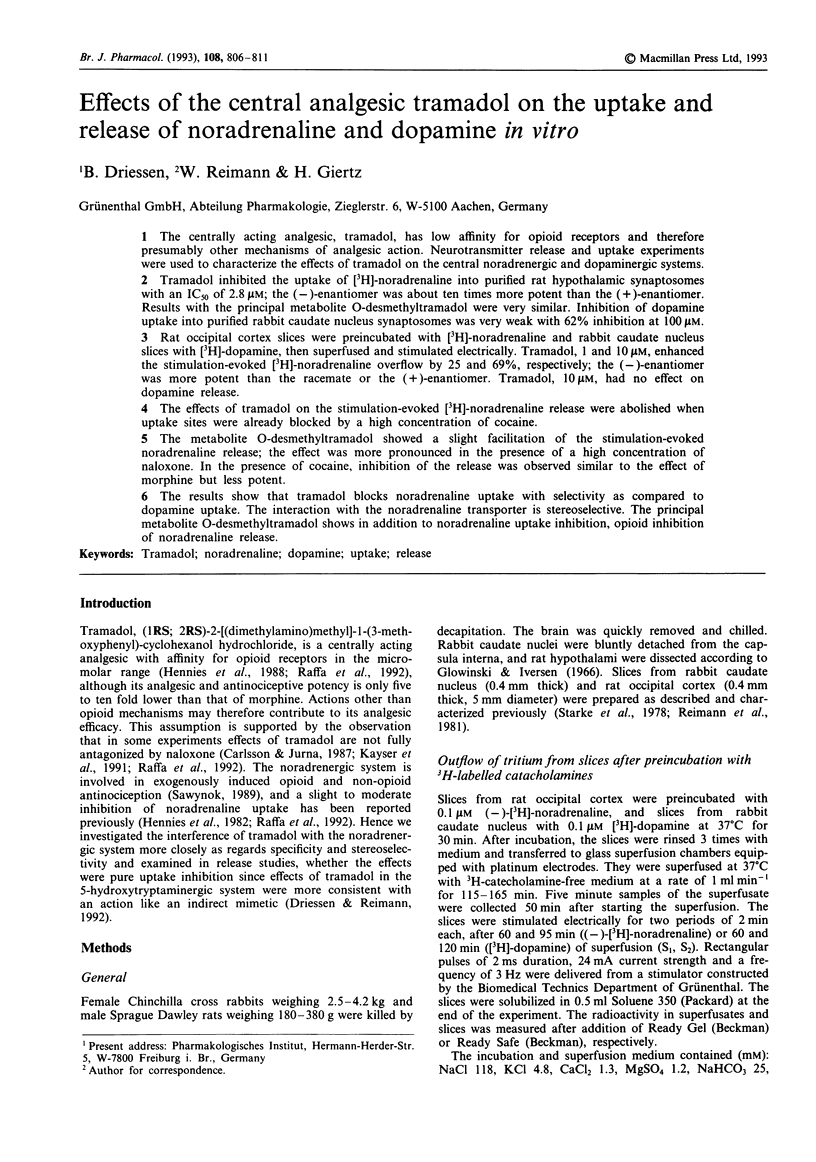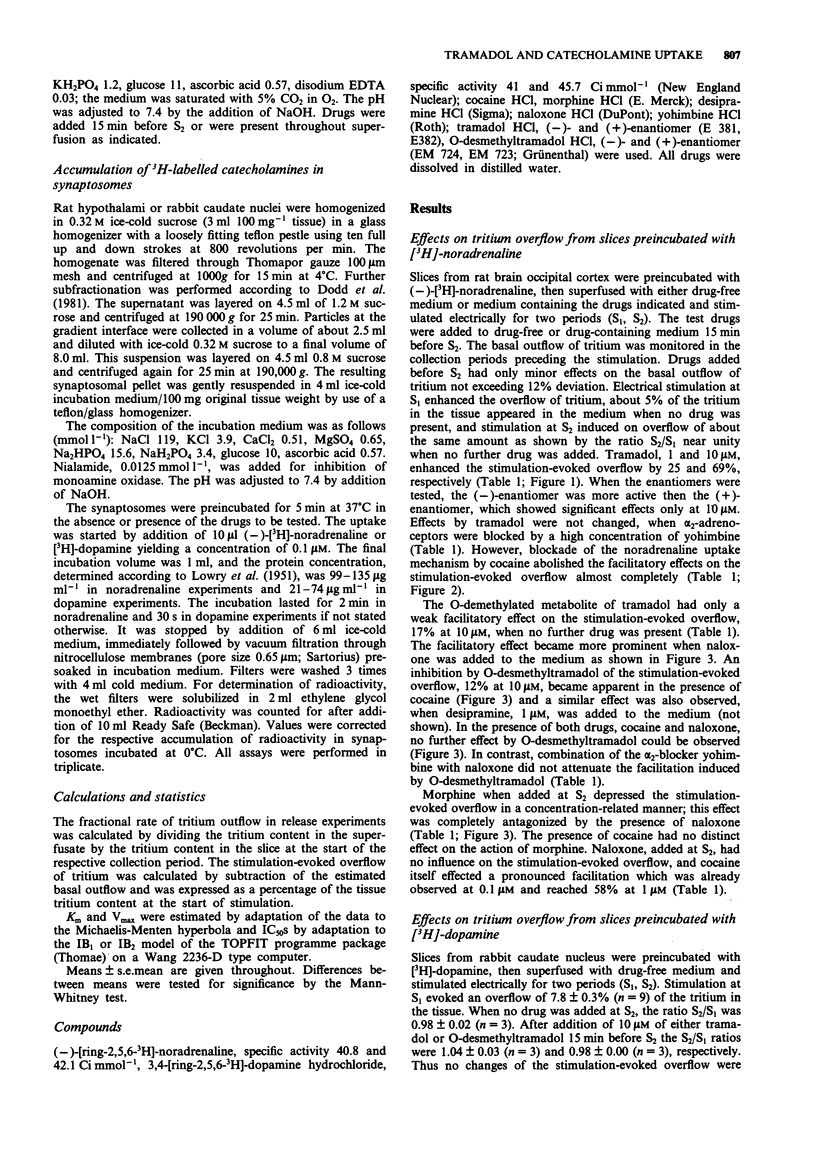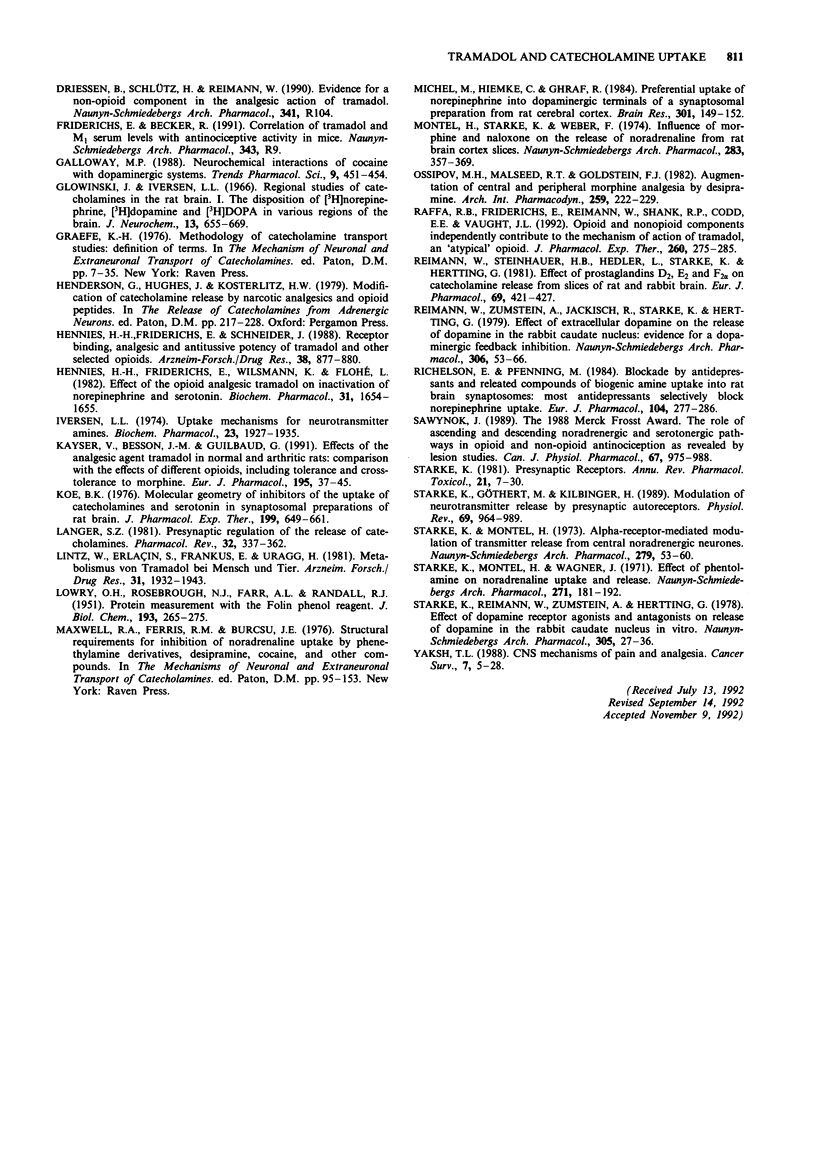Abstract
1. The centrally acting analgesic, tramadol, has low affinity for opioid receptors and therefore presumably other mechanisms of analgesic action. Neurotransmitter release and uptake experiments were used to characterize the effects of tramadol on the central noradrenergic and dopaminergic systems. 2. Tramadol inhibited the uptake of [3H]-noradrenaline into purified rat hypothalamic synaptosomes with an IC50 of 2.8 microM; the (-)-enantiomer was about ten times more potent than the (+)-enantiomer. Results with the principal metabolite O-desmethyltramadol were very similar. Inhibition of dopamine uptake into purified rabbit caudate nucleus synaptosomes was very weak with 62% inhibition of 100 microM. 3. Rat occipital cortex slices were preincubated with [3H]-noradrenaline and rabbit caudate nucleus slices with [3H]-dopamine, then superfused and stimulated electrically. Tramadol, 1 and 10 microM, enhanced the stimulation-evoked [3H]-noradrenaline overflow by 25 and 69%, respectively; the (-)-enantiomer was more potent than the racemate or the (+)-enantiomer. Tramadol, 10 microM, had no effect on dopamine release. 4. The effects of tramadol on the stimulation-evoked [3H]-noradrenaline release were abolished when uptake sites were already blocked by a high concentration of cocaine. 5. The metabolite O-desmethyltramadol showed a slight facilitation of the stimulation-evoked noradrenaline release; the effect was more pronounced in the presence of a high concentration of naloxone. In the presence of cocaine, inhibition of the release was observed similar to the effect of morphine but less potent. 6. The results show that tramadol blocks noradrenaline uptake with selectivity as compared to dopamine uptake. The interaction with the noradrenaline transporter is stereoselective.(ABSTRACT TRUNCATED AT 250 WORDS)
Full text
PDF





Selected References
These references are in PubMed. This may not be the complete list of references from this article.
- Bauman P. A., Maitre L. Is drug inhibition of dopamine uptake a misinterpretation of in vitro experiments? Nature. 1976 Dec 23;264(5588):789–790. doi: 10.1038/264789a0. [DOI] [PubMed] [Google Scholar]
- Carlsson K. H., Jurna I. Effects of tramadol on motor and sensory responses of the spinal nociceptive system in the rat. Eur J Pharmacol. 1987 Jul 2;139(1):1–10. doi: 10.1016/0014-2999(87)90491-2. [DOI] [PubMed] [Google Scholar]
- Chesselet M. F. Presynaptic regulation of neurotransmitter release in the brain: facts and hypothesis. Neuroscience. 1984 Jun;12(2):347–375. doi: 10.1016/0306-4522(84)90058-7. [DOI] [PubMed] [Google Scholar]
- Dodd P. R., Hardy J. A., Oakley A. E., Edwardson J. A., Perry E. K., Delaunoy J. P. A rapid method for preparing synaptosomes: comparison, with alternative procedures. Brain Res. 1981 Dec 7;226(1-2):107–118. doi: 10.1016/0006-8993(81)91086-6. [DOI] [PubMed] [Google Scholar]
- Driessen B., Reimann W. Interaction of the central analgesic, tramadol, with the uptake and release of 5-hydroxytryptamine in the rat brain in vitro. Br J Pharmacol. 1992 Jan;105(1):147–151. doi: 10.1111/j.1476-5381.1992.tb14226.x. [DOI] [PMC free article] [PubMed] [Google Scholar]
- Galloway M. P. Neurochemical interactions of cocaine with dopaminergic systems. Trends Pharmacol Sci. 1988 Dec;9(12):451–454. doi: 10.1016/0165-6147(88)90137-x. [DOI] [PubMed] [Google Scholar]
- Glowinski J., Iversen L. L. Regional studies of catecholamines in the rat brain. I. The disposition of [3H]norepinephrine, [3H]dopamine and [3H]dopa in various regions of the brain. J Neurochem. 1966 Aug;13(8):655–669. doi: 10.1111/j.1471-4159.1966.tb09873.x. [DOI] [PubMed] [Google Scholar]
- Hennies H. H., Friderichs E., Schneider J. Receptor binding, analgesic and antitussive potency of tramadol and other selected opioids. Arzneimittelforschung. 1988 Jul;38(7):877–880. [PubMed] [Google Scholar]
- Hennies H. H., Friderichs E., Wilsmann K., Floh e L. Effect of the opioid analgesic tramadol on inactivation of norepinephrine and serotonin. Biochem Pharmacol. 1982 Apr 15;31(8):1654–1655. doi: 10.1016/0006-2952(82)90398-7. [DOI] [PubMed] [Google Scholar]
- Iversen L. L. Uptake mechanisms for neurotransmitter amines. Biochem Pharmacol. 1974 Jul 15;23(14):1927–1935. doi: 10.1016/0006-2952(74)90250-0. [DOI] [PubMed] [Google Scholar]
- Kayser V., Besson J. M., Guilbaud G. Effects of the analgesic agent tramadol in normal and arthritic rats: comparison with the effects of different opioids, including tolerance and cross-tolerance to morphine. Eur J Pharmacol. 1991 Mar 19;195(1):37–45. doi: 10.1016/0014-2999(91)90379-5. [DOI] [PubMed] [Google Scholar]
- Koe B. K. Molecular geometry of inhibitors of the uptake of catecholamines and serotonin in synaptosomal preparations of rat brain. J Pharmacol Exp Ther. 1976 Dec;199(3):649–661. [PubMed] [Google Scholar]
- LOWRY O. H., ROSEBROUGH N. J., FARR A. L., RANDALL R. J. Protein measurement with the Folin phenol reagent. J Biol Chem. 1951 Nov;193(1):265–275. [PubMed] [Google Scholar]
- Langer S. Z. Presynaptic regulation of the release of catecholamines. Pharmacol Rev. 1980 Dec;32(4):337–362. [PubMed] [Google Scholar]
- Lintz W., Erlaçin S., Frankus E., Uragg H. Metabolismus von Tramadol bei Mensch und Tier. Arzneimittelforschung. 1981;31(11):1932–1943. [PubMed] [Google Scholar]
- Michel M., Hiemke C., Ghraf R. Preferential uptake of norepinephrine into dopaminergic terminals of a synaptosomal preparation from rat cerebral cortex. Brain Res. 1984 May 28;301(1):149–152. doi: 10.1016/0006-8993(84)90413-x. [DOI] [PubMed] [Google Scholar]
- Montel H., Starke K., Weber F. Influence of morphine and naloxone on the release of noradrenaline from rat brain cortex slices. Naunyn Schmiedebergs Arch Pharmacol. 1974;283(4):357–369. doi: 10.1007/BF00501109. [DOI] [PubMed] [Google Scholar]
- Ossipov M. H., Malseed R. T., Goldstein F. J. Augmentation of central and peripheral morphine analgesia by desipramine. Arch Int Pharmacodyn Ther. 1982 Oct;259(2):222–229. [PubMed] [Google Scholar]
- Raffa R. B., Friderichs E., Reimann W., Shank R. P., Codd E. E., Vaught J. L. Opioid and nonopioid components independently contribute to the mechanism of action of tramadol, an 'atypical' opioid analgesic. J Pharmacol Exp Ther. 1992 Jan;260(1):275–285. [PubMed] [Google Scholar]
- Reimann W., Steinhauer H. B., Hedler L., Starke K., Hertting G. Effect of prostaglandins D2, E2 and F2alpha on catecholamine release from slices of rat and rabbit brain. Eur J Pharmacol. 1981 Feb 19;69(4):421–427. doi: 10.1016/0014-2999(81)90445-3. [DOI] [PubMed] [Google Scholar]
- Reimann W., Zumstein A., Jackisch R., Starke K., Hertting G. Effect of extracellular dopamine on the release of dopamine in the rabbit caudate nucleus: evidence for a dopaminergic feedback inhibition. Naunyn Schmiedebergs Arch Pharmacol. 1979 Jan;306(1):53–60. doi: 10.1007/BF00515593. [DOI] [PubMed] [Google Scholar]
- Richelson E., Pfenning M. Blockade by antidepressants and related compounds of biogenic amine uptake into rat brain synaptosomes: most antidepressants selectively block norepinephrine uptake. Eur J Pharmacol. 1984 Sep 17;104(3-4):277–286. doi: 10.1016/0014-2999(84)90403-5. [DOI] [PubMed] [Google Scholar]
- Sawynok J. The 1988 Merck Frosst Award. The role of ascending and descending noradrenergic and serotonergic pathways in opioid and non-opioid antinociception as revealed by lesion studies. Can J Physiol Pharmacol. 1989 Sep;67(9):975–988. doi: 10.1139/y89-154. [DOI] [PubMed] [Google Scholar]
- Starke K., Göthert M., Kilbinger H. Modulation of neurotransmitter release by presynaptic autoreceptors. Physiol Rev. 1989 Jul;69(3):864–989. doi: 10.1152/physrev.1989.69.3.864. [DOI] [PubMed] [Google Scholar]
- Starke K., Montel H. Alpha-receptor-mediated modulation of transmitter release from central noradrenergic neurones. Naunyn Schmiedebergs Arch Pharmacol. 1973;279(1):53–60. doi: 10.1007/BF00502067. [DOI] [PubMed] [Google Scholar]
- Starke K., Montel H., Wagner J. Effect of phentolamine on noradrenaline uptake and release. Naunyn Schmiedebergs Arch Pharmakol. 1971;271(2):181–192. doi: 10.1007/BF00998579. [DOI] [PubMed] [Google Scholar]
- Starke K. Presynaptic receptors. Annu Rev Pharmacol Toxicol. 1981;21:7–30. doi: 10.1146/annurev.pa.21.040181.000255. [DOI] [PubMed] [Google Scholar]
- Starke K., Reimann W., Zumstein A., Hertting G. Effect of dopamine receptor agonists and antagonists on release of dopamine in the rabbit caudate nucleus in vitro. Naunyn Schmiedebergs Arch Pharmacol. 1978 Oct;305(1):27–36. doi: 10.1007/BF00497003. [DOI] [PubMed] [Google Scholar]
- Yaksh T. L. CNS mechanisms of pain and analgesia. Cancer Surv. 1988;7(1):5–28. [PubMed] [Google Scholar]


